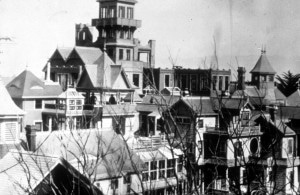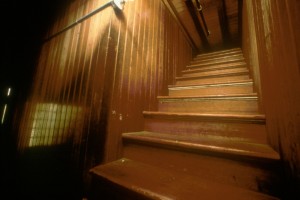All stories, says Larry Brooks, have structure. And, to employ my own analogy, so do all buildings. But not all buildings are created equal:

You might recognize this place, or the legend behind it. The owner believed that her house must be under construction always, or she would die. But they couldn’t use a master building plan.
 Considering that, the Winchester Mystery House is pretty well-built. Yeah, it has stairs that lead to nowhere and doors that open out from the second floor (no stairs on that one—maybe move those first stairs over there?). It’s fun—it’s a blast to explore, and I bet Sarah Winchester had an awesome time throwing in every element she could think of.
Considering that, the Winchester Mystery House is pretty well-built. Yeah, it has stairs that lead to nowhere and doors that open out from the second floor (no stairs on that one—maybe move those first stairs over there?). It’s fun—it’s a blast to explore, and I bet Sarah Winchester had an awesome time throwing in every element she could think of.
It has a decent foundation—instead of leveling it, the 1906 San Francisco earthquake only knocked off the top three stories. After the quake it stood four stories. The remaining structure is a rambling, 160-room, 4.5-acre mansion. It requires more than 20,000 gallons of paint to coat the whole thing once—and once you finish, it’s time to start painting again.
I think we’ve all gotten to the end of a story, looked back and seen our own Winchester Mystery Structure. The Winchester Mystery House has structure. In some sense, it has architecture—but not really. There is no plan, and the closest thing they had to a designer (architect) was a crazy woman.

And “rambling” is right. Dead ends, doors and promises that go nowhere, accidental MacGuffins. . . . My real “Winchester Mystery Story” was my second novel. I think I’ve blocked out most of the horrors by now, but I do remember rewriting the last third of the story some three times. Eventually, I got tired of writing stories that looked like they were designed by a crazy woman.
I wish I could say that was my last Winchester Mystery Story, but even in the last few years, with a novel I plotted (though waaay too loosely), I’ve found that same problem of dead ends and lost threads and a plot that meanders without any purpose, etc. While every first draft probably has some ideas that didn’t come to fruition by the end—and they all need editing!—a true “Winchester Mystery Story” might very well be unfixable.
When your first novel is . . . well, your first novel, and your second novel is unfixable, it’d be pretty easy to give up, right? Although I fell out of love with the story LONG before I found a solution to its plot problems, it’s probably a good thing I didn’t realize just how fatally flawed the story was.

The whole experience pointed me toward how valuable it could be to actually plan the story in advance. That plotting thing didn’t “kill” my “muse”—instead, plotting helped to strengthen my stories. It seems like a lot of writers experience a “conversion” to plotting once they get over the mystique of the “organic” story. Pantsing does work for some people, but for me, plotting is a much better (and more structurally sound, and less rambling!) way to build a story.
What do you think? Have you ever written a “Winchester Mystery Story”? Are you a converted plotter?
Photo credits: exterior shot and stairs to nowhere courtesy of the Winchester Mystery House; rooves—the_photographer; windows to windows—Emily Hoyer


I visited the Winchester Mansion in 1968 and still remember the tour vividly. I have to admit I’ve written more than one Winchester Mystery Story because, up until recently, I was a “pantster” who did lots of research very little advance plotting. When my 2012 NaNoWriMo project stalled not even a quarter of the way in, it became clear I needed to change my method. I’m signed up for Camp NaNoWriMo in April, and in addition to all my research, I’ve done some serious work on a plot outline. So, I guess you could say I’m a plotter in the making.